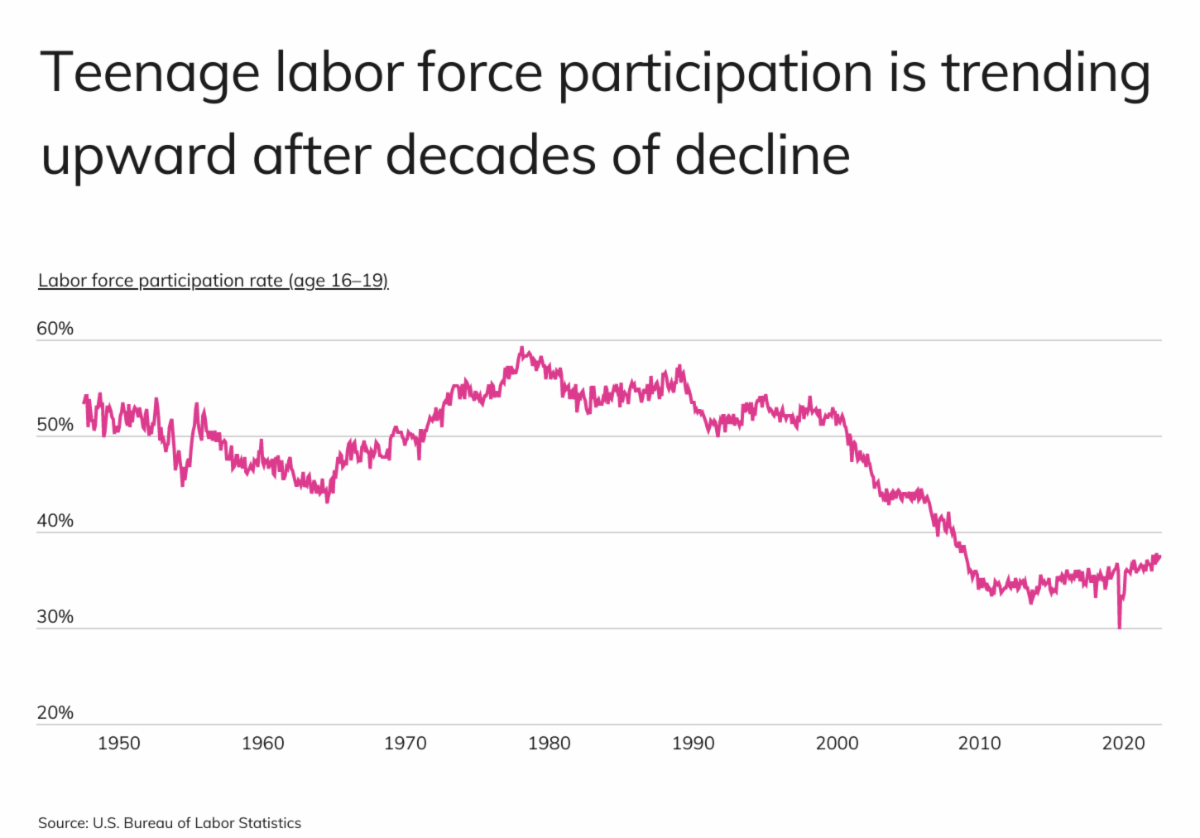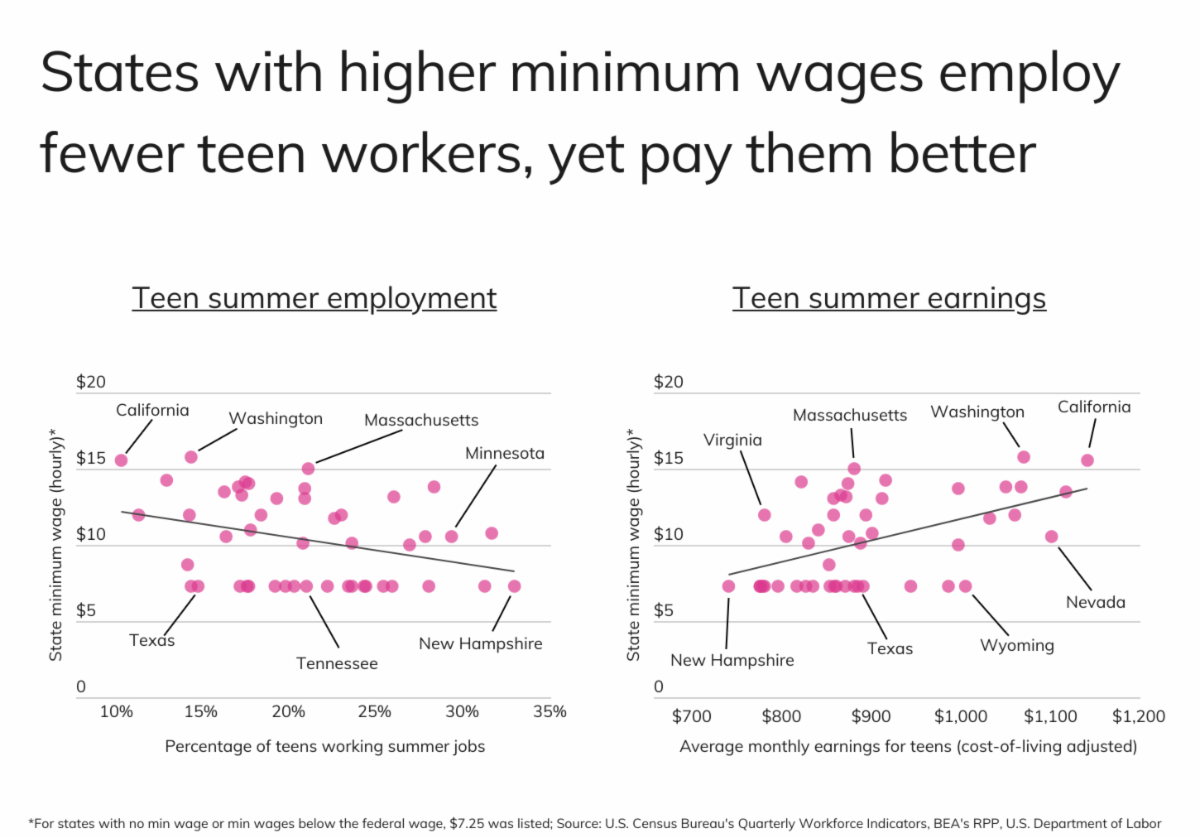
During the 1960s and 1970s—amid the post World War II economic boom—teen labor force participation increased steadily, hitting a peak of 59.3% in August of 1978. However, this rate gradually decreased throughout the 1980s and 1990s and experienced a significant decline in the early 2000s. By May 2011, the teenage labor force participation rate had plummeted to a mere 33.3%.
Although there were slight improvements following the Great Recession, it wasn't until the COVID-19 pandemic that the demand for teenage workers increased significantly. Following the initial lockdown period, many adults were hesitant to return to work due to health concerns, childcare issues, and challenging customer interactions. Teenagers filled in these job vacancies, and as a result, the teenage labor force participation rate began to grow, sustaining levels not seen consistently since early 2009. With ongoing labor shortages continuing to plague the service sector, the teenage labor force participation rate has continued to grow and reached 37.4% in March 2023.
While teenage labor force participation is up nationally, data from the U.S. Census Bureau shows that a greater proportion of teens tend to work summer jobs in states with lower minimum wages. In fact, research from the Congressional Budget Office suggests that each 10% increase in minimum wage results in a 0.7% decrease in teenage employment.

The relationship between raising the minimum wage and teen employment is a complex and contentious issue. While proponents point to its positive effects on reducing poverty, opponents of minimum wage increases argue that higher wages entice older workers to apply for roles where teenagers are typically employed, thereby increasing competition. Further, as labor costs increase, employers may be less willing to hire and train less experienced and less productive workers, such as teens.
At the state level, New Hampshire has the highest percentage of teenagers working summer jobs at 32.9%, followed closely by South Dakota and Wisconsin, with teen employment rates of 31.6% and 31.2%, respectively. Both New Hampshire and Wisconsin have minimum wages set at $7.25 per hour, matching the federal minimum, while South Dakota currently offers $10.80 per hour. Meanwhile, the three states with the lowest percentage of teens working summer jobs—California, Hawaii, and New York—all have state minimum wage laws that exceed $12.00 per hour.
Despite the lower rates of teen employment in states with higher minimum wages, the increased wages do benefit the teens who are able to secure work, particularly since many teens work jobs that pay at or near the minimum wage. For instance, California, which has the lowest rate of teen summer employment at just 10.4%, has the highest teen wages in the country at an average of $1,141 per month after adjusting for cost of living, due in part to its $15.50 per hour minimum wage.
=

Regionally, teen summer wages largely mirror state minimum wage laws. In particular, states located on the West Coast and in the Northeast are more likely to have minimum wages that exceed the federal minimum, and consequently, teens in these states tend to earn more in their summer jobs, even after accounting for cost-of-living differences. For example, in addition to California, teens in Oregon, Nevada, Washington, and Arizona earn over $1,000 per month on average.
In contrast, states in the South and Midwest typically report lower summer wages for teens. This may be due to a variety of factors, such as lower minimum wage rates, local economic conditions, demographics, and cultural norms.
To determine the locations with the best-paying summer jobs, researchers at Cool Jobs analyzed the latest data from the U.S. Census Bureau, the Bureau of Economic Analysis, and the U.S. Department of Labor. The researchers ranked states by the average monthly earnings for teens working summer jobs after adjusting for cost of living. In the event of a tie, states were sorted by the unadjusted average monthly earnings for teens working summer jobs.
The analysis found that teenagers in Georgia earn an average of $776 per month in their summer jobs, after adjusting for cost of living, compared to the national average of $880. Among the 47 states with complete data available, Georgia is the 3rd worst-paying for teens working summer jobs. Here is a summary of the data for Georgia:
-
Average monthly earnings for teens working summer jobs (adjusted): $776
-
Average monthly earnings for teens working summer jobs (actual): $743
-
Percentage of teens working summer jobs: 17.6%
-
Total teens working summer jobs: 136,137
For reference, here are the statistics for the entire United States:
-
Average monthly earnings for teens working summer jobs (adjusted): $880
-
Average monthly earnings for teens working summer jobs (actual): $880
-
Percentage of teens working summer jobs: 18.1%
-
Total teens working summer jobs: 3,992,460
For more information, a detailed methodology, and complete results, you can find the original report on Cool Jobs’s website: https://www.cooljobs.com/blog/cities-with-the-best-paying-summer-jobs/
|
|
|





